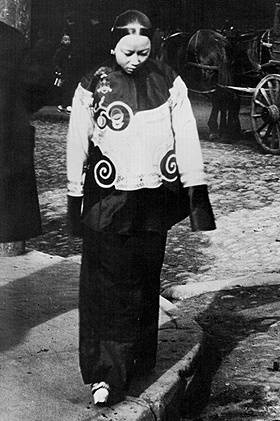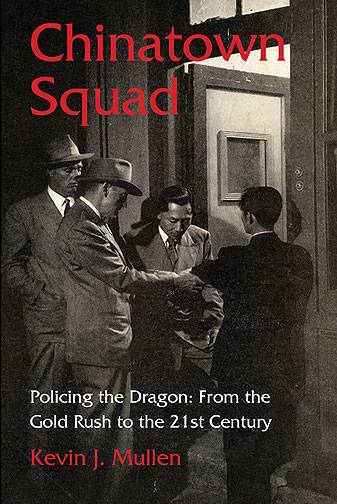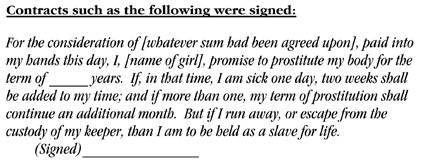Chinatown Vice
Historical Essay
By Kevin J. Mullen, excerpted with permission from "Chinatown Squad"
Arnold Genthe originally called this photo "Slave Girl in Holiday Attire."
The Fisk Committee
The Examiner thereupon mounted a press campaign against the administration. It soon extended to fresh charges that graft was being collected in Chinatown to let the vice run. The paper was able to convince the state legislature that an investigation into Chinatown affairs was called for. In February 1901, a commission authorized by a resolution of Assemblyman Arthur Fisk was convened in San Francisco to study the issue. The Legislative Investigating Committee—or Fisk Committee, so named after its author—began its deliberations in San Francisco on February 4.
While, in the end, the Committee’s findings did not result in any meaningful reforms, the testimony given at the hearings does shed some light on police/Chinatown relations at the time. The first witness was Chief Sullivan. He admitted that he had heard of the “licensing” idea from the Seattle chief of police and had passed the idea on to Phelan. He also admitted, under questioning, that he had been fully aware of the dens in Chinatown, but had done nothing to close them down. When confronted with the state law prohibiting the compounding of a crime, Sullivan admitted—much to the amusement of those present—that he had never read the penal code. The fact that he was able to order gamblers to move upstairs from ground floor operations, and the fact that they did so, said the Examiner suggested that the police were in collusion with the gamblers. “He came near to admitting all charges,” reported the paper, “right down the line.”
Next to testify was Captain John Seymour, who reported reluctantly to the Committee that, on December 21, 1900, Ho Yow, the Chinese Consul, telephoned him that the Chinese gamblers were collecting money to pay the Chinatown Squad, and that Sergeant Brophy’s exactions were even more oppressive than those of Sergeant Mahoney. The Captain testified that he had informed Chief Sullivan of the consul’s report the following day, a fact that the chief disputed.
Mayor Phelan also took the stand and admitted that there had been a longstanding general tolerance of Chinatown vice. The Examiner suggested that the mayor’s personal tolerance of such behavior might have been motivated by the fact that his brother-in–law, Frank Sullivan, had extensive real estate holdings in the area and thus profited greatly from the high rents the vice operators were able to pay.
Captain George Wittman was then called to the stand. He testified that he commanded the Northern Police District, which encompassed Chinatown, but that the Chinatown Squad reported directly to the chief. Wittman said he had conducted more raids in Chinatown than anyone else and that, on one occasion, he had captured 75 slave girls and turned them over to the Presbyterian Mission. After a visit to Eastern departments some years earlier, he testified, he brought up the idea of licensing to Chief Patrick Crowley, who rejected it because it would cause “too much of a howl.” As to current enforcement practices, he said that, when he took over the district, he allowed existing brothels to operate, as ordered, but allowed no new ones to open.
Retired Chief Crowley was called to the stand. He testified that there had always been rumors of corruption in Chinatown, some of which he believed to be true. He cited his dismissal of Chief Clerk Hall and other officers in 1894. He also recounted that, on one occasion, six or seven years before, a man offered him $6,000 to let prostitutes operate out of ground-floor addresses. The old chief testified that it would take 100 officers to properly police Chinatown. During his testimony, Chief Sullivan put that figure at 300. Former—and future—Chief William Biggy had said the job could be done with 30 properly deployed and motivated officers.
In the midst of the Committee hearings, Assemblyman Eli Wright caused a minor sensation and embarrassed the Department by going personally to Chinatown. There, he said, he played fan tan openly—while a police officer stood a half block away—and purchased a lottery ticket which he brought back to the proceedings.
Committee members also visited the Presbyterian Mission on Sacramento Street, where they received firsthand testimony from mission workers, including the director, Donaldina Cameron, and some of the slave girls they had rescued. Three of the rescued girls told the Commission that they had been sold for between $2,000 and $3,000 apiece. The practice was so open that in January one merchant preparing to depart for China had publicly advertised his remaining goods for sale. Those goods included five female slaves. Infant girls, the Committee was told, went for between $100 and $150.
The mission women testified that the police were at best apathetic about the plight of the girls “and there were intimations that whenever the mission workers appealed to the police for help, the Chinese were notified and the slave girls were spirited away.” Thereafter, the mission stopped appealing to the police for help. On one occasion, it was testified, after a girl had been rescued from a brothel operator on property owned by Frank Sullivan, large wooden gates were built across the mouth of the alley to prevent mission workers from entering.
Frank Kane, Secretary for the Society for the Prevention of Vice, testified that he was constantly thwarted in his attempts to rescue girls from the brothels by a watchman named Finn, who was always on hand to warn vice operators. (Finn was performing the service previously performed by Chinatown special police officers until their function was abolished by the 1878 McCoppin Act.) When asked if the Chinese paid protection to the police, Kane said that he had heard of it. But he declined to name the Chinese who told him, fearing that the man would be murdered. He did believe, though, that the slave operations were being protected by the police. When anything came out of the Hall of Justice, whether it be an arrest warrant or a prospective raid, the Chinese always had advance knowledge.
After 10 days of testimony, the Committee returned to Sacramento and, a few days later, issued its report. There were no surprises. The report substantially confirmed everything the Examiner had been reporting. What the process also showed is that, except for the Examiner’s headlines, there was no sense of outrage. It became clear that the citizens of San Francisco pretty much knew what was going on and did not much care.
Chinatown Squad by Kevin Mullen (click "books" link)
Example of a contract for a concubine in the late 19th/early 20th centuries. From Dr. Weirde's Guide to Mysterious San Francisco.
In the 19th and early 20th centuries, Jackson & Washington Streets were lined with "cribs," makeshift twelve-by-fifteen-foot stalls where the favors of Chinese girls could be purchased. The cribs were generally divided into two rooms by a curtain; through the inset barred window in the narrow door, the girls enticed men by displaying their upper bodies.
--Dr. Weirde



